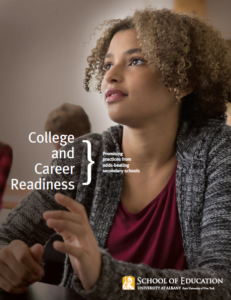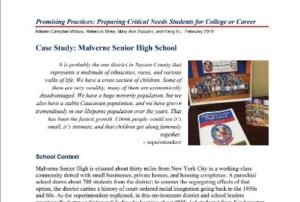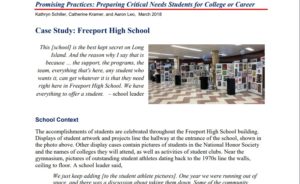Catalysts for Improvement in Positive Outlier Schools: Lessons about Innovation and Resilience in Tumultuous Times
by Kristen C. Wilcox
The NYKids College and Career Readiness study identified “positive outlier” schools that consistently produced better-than-predicted graduation outcomes for diverse student sub-populations and did so over several years.
New York State Regents and Advanced Regents diploma rates for subgroups were regressed against poverty and English language learner rates to derive the sample. The data set included observation tour memos, interviews and focus groups with over 100 leaders and educators, documentary evidence, and researcher interpretive memos.
We focused in on three schools in a recent analysis as they had experienced a significant uptick in student diversity and faced a number of challenges, such as rising poverty, due to changes in their respective communities. Despite these challenges, they produced an upward trend in graduation rates. What accounts for this apparent capacity to overcome challenge and turn challenge into opportunity to innovate?
Histories of Challenge
The exemplars NYKids researchers focused on in a recent analysis are in Port Chester, Malverne, and. Freeport.
Port Chester was characterized by study participants as a “service community” because it has supplied a workforce for surrounding wealthier districts. The district witnessed significant shifts in student demographics over several decades. In particular, Port Chester welcomed increasing numbers of English language learners (ELLs), primarily from Central and South America, while at the same time experiencing growing and significant income disparities among its in-district families and those in adjoining neighborhoods. For example, while in the late 1990’s the district served a majority white population, by the mid-2010’s over 84% of students were identified as non-white and, at 18%, the school by 2018 served double the state average in percentages of ELLs.
Malverne, like Port Chester, experienced a significant demographic shift over several decades. The district was the site of forced integration in the 1990’s, at which time many white families left the district. By the early 2000’s, graduation rates were in decline, dropping from 92% to 77%, with graduation rates among particular subgroups of students particularly low. For example, in 2006, graduation rates for ELLs hovered around 20% and reached only 55% among students with disabilities. For these reasons, the high school was identified by the state as a school in need of improvement.
Per state regulatory policies, this school had to demonstrate improved outcomes within a set period of time or face the risk of increased state oversight or even takeover. Meanwhile, the district and school leaders saw increases in the overall diversity of the population they served, with the largest uptick among their Hispanic/Latinx and African American populations. School violence and leader turnover plagued the district for many years until a new superintendent (with years of experience in a nearby district and pulled out of retirement) and new principal (pulled from the teaching and leader ranks in the district) began an effort to address low expectations through new non-negotiables – also discussed next.
At Freeport, the third school we highlight here, according to some long-time employees, they were especially hard-hit by gang violence. This violence “spilled over into the building” (Freeport teacher) in the mid-90’s and during this period the district experienced considerable principal turnover in a short period of time. Even as educators continued to serve families who had lived in the community and attended schools in the district for generations, Freeport increasingly welcomed immigrant youth and families, particularly populations from the Caribbean and Central America. By 2016-17, 16% of Freeport’s students were identified as ELLs, 64% were Hispanic/Latinx, and 20-25% of the incoming ninth graders were immigrants from a number of different countries. Some of these new immigrant students were reuniting with family members after many years of separation and tended to move in and out of the district throughout the school year, requiring adaptations to instructional staff, social-emotional support services, and new parent and family outreach efforts.
Catalysts for Innovation and Resilience
What we noticed in these schools were particular catalysts for innovation that also encouraged resilience; lessons so important at this time.
-
Catalyst #1: Center the Message on Service, Caring, and Responsibility
“I try to get people to want to work hard for me just by treating them respectfully and fairly. I try to show them that I care about their well-being day in and day out”. —Malverne Principal
-
Catalyst #2: Work as a Team Focused on the Same Vision
“When it comes to [our principal], we rely on him for the vision. What are the goals we are going to try to achieve for each academic year? And so, what we try to do is we try to brainstorm … it’s always a team mentality because we understand that things only get accomplished when we work as a team. And each member of that team understands what their individual responsibilities are to make sure it can happen. Which is why we have our own specific roles that go ahead and make sure that everyone has his specific role in addition to managing their caseloads to make sure that we’re achieving our goals”. –Port Chester Teacher
-
Catalyst #3: Use Data to Measure Performance, Innovate, and Repeat
“The meetings gear towards: what are the improvements we need? What are we not doing anymore? How is it [improvement] measured? What can we add? and its meetings such as that [which] build the leadership because nobody is going to come to the table unprepared. I’m going to speak the truth because everybody is going to know and they want their department to shine. Everybody says, “This is what’s going on in my department.” It’s always something new, it’s always something rich. I have to say that the Superintendent does the same thing – between his cabinet meetings, his SCL meetings, his committee meetings. Meetings are very important in the district, and everything is pretty much data driven. – Freeport District Leader
The COVID-19 school closures have forced what has been an unforeseeable immediate need to innovate and engage in resilience-building as individuals and as a collective. The catalysts outlined here are like anchors for those who seek to build an innovative and resilient infrastructure in their schools for this and future crises.
Learn about these schools, and about catalysts for improvement, in a presentation on Catalysts for Improvement at the 2020 Carnegie Virtual Summit, and stay tuned for more research about technology integration and technology-related resources during school closures in NYKids’ Research-Based Resource Collections page and future blogs. We hope these are useful and welcome comments and suggestions for topics you would like to read more about at nykids@albany.edu





